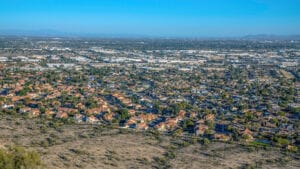Whirlwind Golf Club in Chandler, Arizona is home to two golf courses … and burrowing owls.
Burrowing owls used to be common in the Phoenix area, but habitat loss has been a huge factor in their declining population, according to the National Audubon Society. Recently, Whirlwind Golf Club partnered with the non-profit Wild at Heart to relocate two burrowing owls.
“Most of the owls … [in the Wild at Heart program] don’t need rehabilitation,” explains Greg Clark, burrowing owl habitat coordinator for Wild at Heart. “They’re just in the way of development.” \
READ ALSO: Ranking Arizona: Top 10 golf courses for 2022
New burrows
Whirlwind Golf Club already had a population of burrowing owls living on one of their courses and the club decided to collaborate with Wild at Heart to home two more, according to Jonathan Williams, director of agronomy for Troon Golf.
Williams further notes that Wild at Heart provided the club with the tools to relocate the owls while the golf club provided the labor. They excavated and reinforced four- to six- feet holes for the birds to have a safe place in which to live.
Aside from wanting to have cute owls on the golf course, Williams decided to go ahead with the project to show the public that golf courses can be environmentally friendly.
“That’s another aspect to this,” Williams says, “showing that golf courses are not this superfund site where people are just killing little birds and destroying the environment. In fact, it’s quite the opposite.”
The first pair of owls released into their new home on the course didn’t stay in the burrows provided for them. However, a pair of burrowing owls thought to be the released owls were spotted near the course by an equestrian center. Wild at Heart considers this a success.
Clark relays that, although Wild at Heart provides burrows for the owls to live in, their main goal is to relocate the owls, rather than rehome them. “We generally refer to it as relocation as opposed to rehoming. What we do is called active translocation,” he says. “Active translocation uses a tent and a certain period of time where the owls are in the tent to build site fidelity to that location, but doesn’t necessarily mean that they will stay at the artificial burrows we provide for them.”
Brianne Kenny, manager of environmental science at Troon Golf, helped organize the collaboration between Wild at Heart and Whirlwind Golf Club.
“When working with animals, it’s very unpredictable and you just have to roll with it,” Kenny says.
Clark adds that burrowing owls decide for themselves whether the burrow provided for them is adequate. What’s important is that they have a new area to live in. “If our work is successful, the owls don’t go back where they’d be in trouble again,” he says.
According to Kenny, another pair will be released at Whirlwind Golf Club. Currently, she says Wild at Heart has 200 burrowing owls, but only two people are in charge of the owls, so they are backtracked.
Golf course helpers
“Burrowing owls can be beneficial to golf courses because they eat some of the pests that golf courses don’t want,” Kenny says. “Golf courses are good places for burrowing owls to live because of the open spaces that it provides.”
According to National Geographic, burrowing owls eat insects and small mammals. They don’t dig the burrows that they live in and instead “borrow” abandoned burrows from ground squirrels or prairie dogs.
Golf courses that are suitable for burrowing owls are “flat, sparsely vegetated land so the owls can get in and out of their burrows and see easily” Kenny says. Ideally, the course is also close to a large natural habitat for the owls.
Burrowing owls first began to lose their natural habitat about 100 years ago, according to Clark. The United States federal government put a bounty on prairie dogs, one of the primary animals that provide burrows for burrowing owls, which led to a drop in the prairie dog population.
“There are no hawks or falcons or other owls that live underground, just burrowing owls,” Clark explains.
Because they rely on their underground homes, the decline in the prairie dog population directly impacted the population of burrowing owls.
“Active irrigated agriculture is where they thrive and that’s where most of the owls are found,” Clark says. “It can be a baseball field, soccer field, greenbelt retention basins or golf courses.”
Adds Kenny, “Golf courses that don’t have an ideal habitat for burrowing owls sometimes take in other types of owls, like great horned owls or barn owls.”
In closing, Kenny encourages all golf courses to consider rehabilitating animals on their land. “A lot of them are open to it,” she says. “The thing we’re working on right now is trying to find where the interest is and then connecting them with the people that need to do it.”




